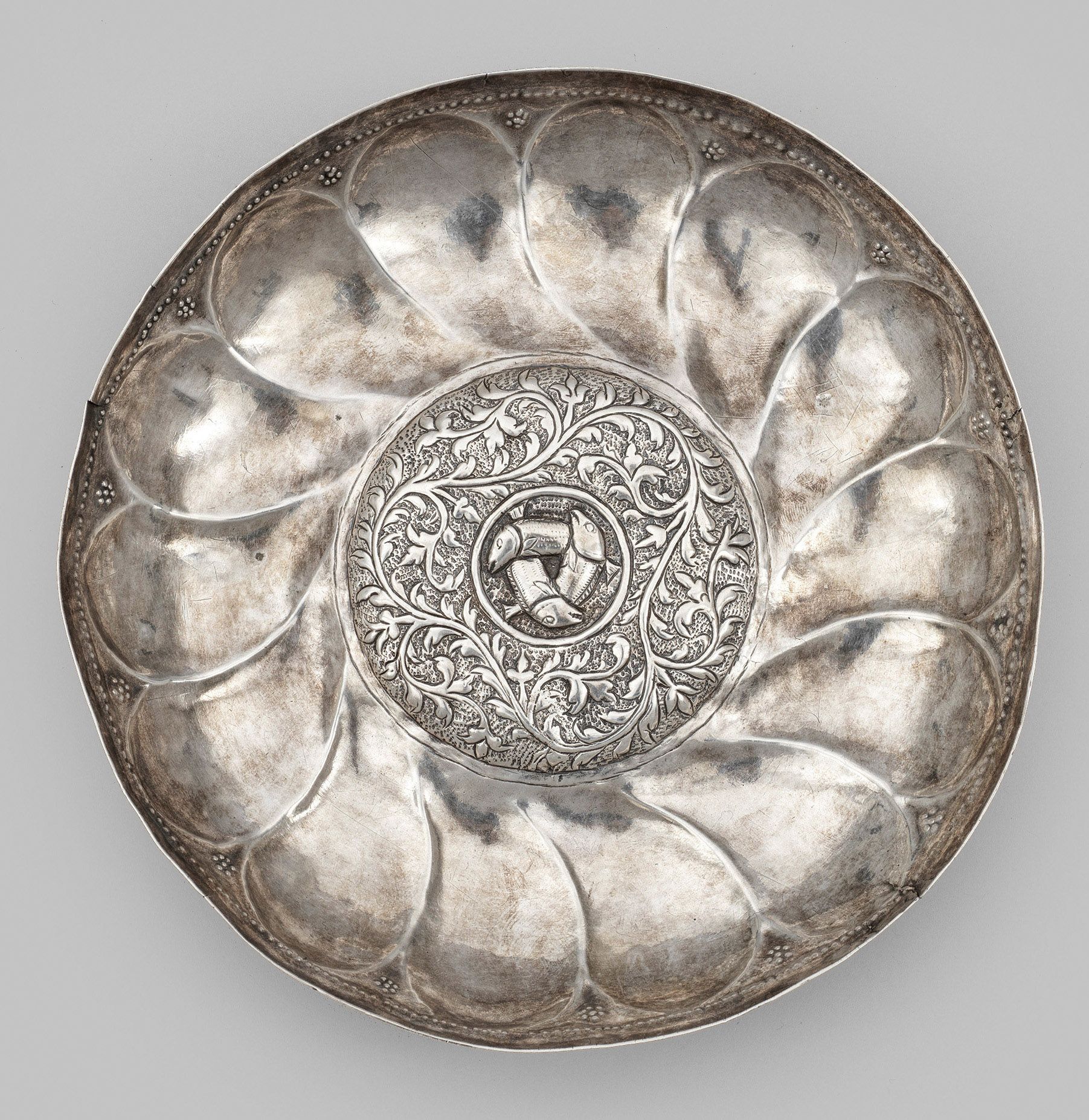Description
Highly significant late Gothic bowl, so-called Omphalos bowl. Silver. Flat, cylindrical stand surrounded by horizontal lines. Slightly hollowed, wide bowl. The wall decorated all around with broad, rotating fish-bubble decoration, the smooth rim zone with a single row of punched pearl bands above stylized flowers of seven-point punched and matching dotted decoration. Domed round mirror framed by two delicate decorative lines, so-called navel. Curved leaf tendril in relief over a chased ground, framing a central round medallion with three intertwined fish. Undisturbed; weight approx. 280 g. H. 4 cm. D. 21 cm. Enclosed: Expertise Prof. Dr. Richter from 05.03.2024. The Roman "patera" and the Greek "phiale" have existed since antiquity. These were equally flat, round bowls, decorated in the center with a bulging navel (Greek "omphalos"). They were originally used as sacrificial bowls or for purification, but were later also used as drinking bowls. The three intertwined fish in the middle of the bowl refer to an early Christian symbol of the Trinity, as the unity of God the Father, the Son Jesus Christ and the Holy Spirit. The so-called fish-bubble decoration probably came to Europe from Asia or Persia via the trade routes. The different cultural influences came together in Venice in particular, the flourishing trading city, and made the port city famous for the production of extraordinary and important art objects. Silver bowls of this type are typical of the late Gothic period. In the 16th century, they were made in a similar way but mostly from copper or brass, such as the so-called cymbal bowls from Nuremberg. A footed bowl with the same raised navel with three intertwined fish, the typical fish bladder decoration and the punched flower rosettes, attributed to Venice 1480 - 1490, is in the Victorian & Albert Museum in London (inv. no. 274-1881), along with another bowl with a different decoration (LOAN:GILBERT.544-2008). A very important probably Italian, Venice Gothic silver footed bowl. Unmarked. Accompanied by an expertise from Prof. Dr. Richter, March 2024. Probably Italy. Venice. Circa 1500.
310
Highly significant late Gothic bowl, so-called Omphalos bowl. Silver. Flat, cylindrical stand surrounded by horizontal lines. Slightly hollowed, wide bowl. The wall decorated all around with broad, rotating fish-bubble decoration, the smooth rim zone with a single row of punched pearl bands above stylized flowers of seven-point punched and matching dotted decoration. Domed round mirror framed by two delicate decorative lines, so-called navel. Curved leaf tendril in relief over a chased ground, framing a central round medallion with three intertwined fish. Undisturbed; weight approx. 280 g. H. 4 cm. D. 21 cm. Enclosed: Expertise Prof. Dr. Richter from 05.03.2024. The Roman "patera" and the Greek "phiale" have existed since antiquity. These were equally flat, round bowls, decorated in the center with a bulging navel (Greek "omphalos"). They were originally used as sacrificial bowls or for purification, but were later also used as drinking bowls. The three intertwined fish in the middle of the bowl refer to an early Christian symbol of the Trinity, as the unity of God the Father, the Son Jesus Christ and the Holy Spirit. The so-called fish-bubble decoration probably came to Europe from Asia or Persia via the trade routes. The different cultural influences came together in Venice in particular, the flourishing trading city, and made the port city famous for the production of extraordinary and important art objects. Silver bowls of this type are typical of the late Gothic period. In the 16th century, they were made in a similar way but mostly from copper or brass, such as the so-called cymbal bowls from Nuremberg. A footed bowl with the same raised navel with three intertwined fish, the typical fish bladder decoration and the punched flower rosettes, attributed to Venice 1480 - 1490, is in the Victorian & Albert Museum in London (inv. no. 274-1881), along with another bowl with a different decoration (LOAN:GILBERT.544-2008). A very important probably Italian, Venice Gothic silver footed bowl. Unmarked. Accompanied by an expertise from Prof. Dr. Richter, March 2024. Probably Italy. Venice. Circa 1500.
